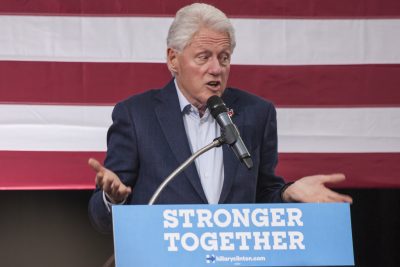
Harlem sets the stage for the annual Harlem Book Fair this week, against the backdrop of a community that is fading to white at lightning speed.
In 2001, Bill Clinton moved his office into 55 West 125th Street, catapulting the legendary — yet disenfranchised — Harlem neighborhood to the top of New York’s gentrification list.
Clinton signed another 10-year lease for his office space last year although the William J. Clinton Foundation will move its offices to New York’s Financial District.
The former president, then considered the first “black” president, was welcomed to the community with open arms. For residents, Clinton’s presence meant things would look up, better police detail, more goods and services. For property owners, Clinton’s presence meant property values would predictably skyrocket.
As property values surged, many black and brown residents were priced out of the market, and were ultimately squeezed out of the neighborhood.
According to the U.S. Census, in 1970, 64 percent of Greater Harlem (area spans from river to river, and from East 96th Street and West 106th Street to West 155th Street), was black. In 2008, that number plummeted to 41 percent.
For mom-and-pop business owners, Clinton’s presence lured the attention of the big box stores, who enjoyed tax breaks and other juicy incentives, not extended to pre-existing businesses. The competition for community dollars became brutal, and put some small businesses out of business.
Rolling out spoke with lifelong Harlem resident April Davis, about the changes she has witnessed in her neighborhood. Davis is the publisher of the successful hyperlocal blog, Around Harlem.
What does gentrification in Harlem look like? What have you seen within the last five years?
There has been a tremendous amount of growth and development of new residences, and some commercial spaces. Most of the new residences were [developed] from city-owned property that had been abandoned, maybe in in the 70s or 80s. Landlords just stopped paying taxes, or whatever, the city took it over, and about 75 percent of the new projects that came from this city land. New York City sold the land to a developer at a discount.
And in turn, that developer rebuilt the property and it was sold to the community, most of the projects have a 50/50 occupancy, where 50 percent of the people come from Harlem … and then 50 percent are just people who are new to the neighborhood. 
There’s been some controversy because some people don’t think it’s fair. It depends on who you talk to; there are pros and cons.
What are some of the improvements that have taken place in Harlem?
The plus side that I like is that a lot of people … have more amenities, things that we didn’t have before.
The part that makes some people upset, is that we’ve always wanted this stuff, but we just couldn’t get it. Now it’s like people want to open up businesses, but there are barriers that exist to local entrepreneurs, that don’t exist for people outside of the community.
What are the barriers that exist for Harlem’s small-business owners?
Getting loans. The Upper Manhattan Empowerment Zone was created through a Bill Clinton government initiative, where ten neighborhoods around the country were given funds to develop their neighborhoods. It started about [eighteen] years ago, that’s when the first Starbucks came to Harlem, [in 1999]. We had the Magic Johnson Cinemas, Old Navy, these big box stores, the government was giving them discounts and rolling out the red carpet, whereas the little mom and pop shop down the block could not get the same loan.
And then after so much uproar from the community about five years into it, you saw the effect of where the money was going, that it wasn’t coming to people in the community, they kind of revised the plan a little bit.
They made some kind of loan fund for current businesses, but even still, it wasn’t as easy. Some people’s experiences have been challenging. A lot of businesses have gone out of business, especially when the recession hit.
Some of the other businesses were able to [maintain], because if you don’t have property taxes, you can stay open. Deals like that were for certain businesses moving into the community. If you were already there, you still have to pay taxes.
What is the cultural look of your community now?
It depends on where you live. Harlem is a big neighborhood that has smaller neighborhoods. You have Morningside Heights; East Harlem, West Harlem, and Central Harlem. With the gentrification thing, which is interesting, there’s almost a 125th street dividing line, where the property below 125th is twice as expensive as the property above 125th.
And a lot of the new development that is below 125th is where you see the really high prices, the market rate apartments that most people in the community can’t afford. So you get the outsiders coming in, people who used to live in downtown Manhattan, have figured out, ‘Hey it’s cheaper for me to get twice as much in Harlem, so let me move uptown.’
What kind of Harlem do you want to see five years from now?
I’d like to see a more equitable Harlem, in that I’m open to whoever wants to live in my neighborhood, I just want the resources to be allocated fairly.
And I want people who lived there to be considered for the same things as the people who haven’t been living there. Whatever it is that you want to do, I want the same support for Old Harlem as for the New Harlem.
And that’s the major complaint that most people have, that Old Harlem is never supported and we see it from the history. All the things that make Harlem great today, were there before, and the greatness wasn’t acknowledged.
Around Harlem blogger April Davis is on Twitter: @AroundHarlem.
Video: Around Harlem Blogger April Davis.














